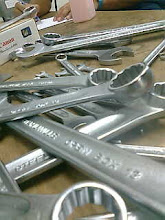After the war, a battered and financially beleaguered Britain struggled to rebuild. Petrol rationing, the lack of resources for manufacturing and low consumer capital made recovery slow. Innovation was strangled by lack of funds and a deeply conservative mindset at the executive level of many firms. Innovative designs were produced, but many proved unsuccessful in the market, or just too expensive. The British Army put a lot of its motorcycles into civilian hands after the war, creating a brief glut of inexpensive, utilitarian motorcycles in the market at a time
when other vehicles were scarce.
But the image of motorcycling was also changing, the result of servicemen returning home. Looking for some sense of identity and freedom, many turned to motorcycling. Café racing, the ‘ton-up’ crowd of leather-jacketed riders, and the newly emerging motorcycle gangs added a darker side to motorcycles that further turned away more conservative buyers. More and more consumers opted for cars as their family vehicle, and motorcycle sales - initially rising after the war, soon slumped again.
Export sales, especially to the USA, accounted for a large proportion of post-war British production. While good for business, it often made many models unavailable or scarce in the domestic market. The USA was a rich market, with only two motorcycle companies of its own in the 1950s: Indian and Harley Davidson. The lighter, faster Triumph, Norton and BSA machines became so popular that US firms fought unsuccessfully to have them banned or heavily taxed. After Indian collapsed, in 53, British machines became even more popular, especially in the race and trials circuits where they dominated the events.
Nineteen fifty-nine was a peak year for the British industry: motorcycle sales and exports were at their highest levels. Flushed with their own success, most companies didn’t bother to look at emerging trends, or take stock of their aging designs. Most of the executives and designers came from pre-War days: they looked back to the glory days of the 30s, not ahead. And as such, they created some beautiful, exciting machines - many were race-oriented, however, an increasingly smaller portion of the market than manufacturers seemed to realize.
Worse, few if any top level people came from within the motorcycle industry: the trend was to hire from outside the industry. The post-war paradigm in business management encouraged manufacturers to replace outgoing executives with graduates from business schools, generally people with financial backgrounds, instead of promoting from within. Engineers - never common in upper management - were increasingly scarce around the board room tables. Decisions were being made more and more by people far removed from the production side.
In the 1960s, middle- and upper-management levels became swollen with employees far removed from design and manufacturing. Management consultants made efficiency studies and wrote endless reports. Financial experts continually changed processes and set up new systems for reporting, stocking and testing. Marketing departments expanded as product lines shrank. Money was poured into studies and increasing management expenses.
Unions also helped the demise. Once powerful forces of social change, British trade unions had ossified into opponents of any change that they perceived as a threat to the workforce. Modern mass production techniques were one of those threats. Management found it easier to continue their labour-intensive 19th-century production lines than get embroiled in fights with aggressive unions determined to preserve the status quo.
The motorcycle industry was in the doldrums and financially in trouble by the early 1960s. Most companies continued to make bikes based on pre-war designs - designs that no longer interested a younger generation. Production quality fell as testing time was shortened by management eager to get bikes into the market sooner.
The scooter craze of the late 1950s-early 1960s helped boost sales, but not for long, and not enough, although it generated a production wave that seemed to presage richer days ahead. In fact, the rush to develop and market scooters cost a lot of motorcycle companies precious resources and capital. The craze crested and the demand dwindled, but the companies didn't seem to notice it until too late. The backlash was greater reluctance to re-tool for new motorcycle designs.
Consumers with more money wanted automobiles, not motorcycles for the family vehicle. The inexpensive Mini car was introduced in 1959, effectively killing sales for the sidecar market. Fifty nine was the last real boom year for British motorcycles - 127,000 bikes were built then. But the manufacturers didn't seem able to read the writing on the wall.
Sunday, 10 July 2011
Subscribe to:
Post Comments (Atom)






0 comments:
Post a Comment